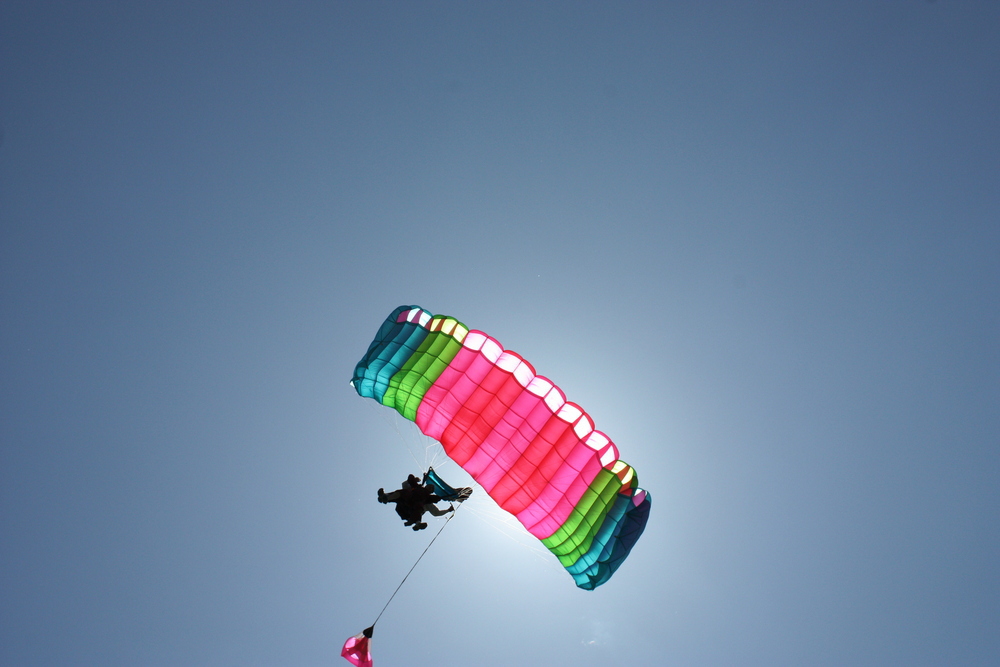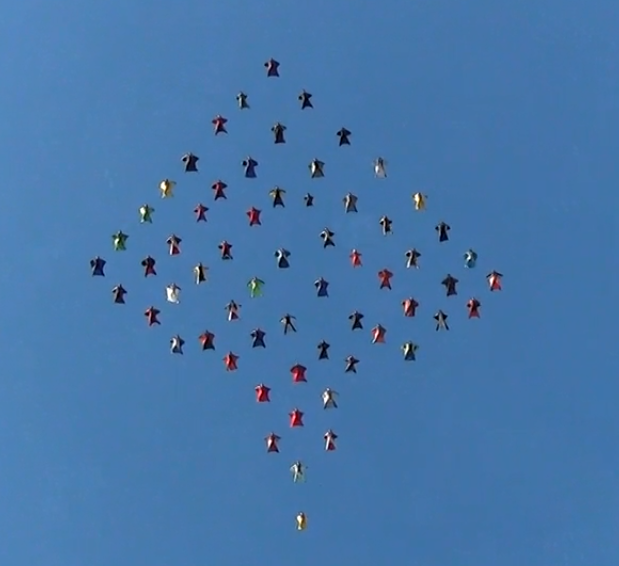Recommended Posts
The111 0
QuoteIsn't this what my calculation proves??? You can't notice 1 ft. when it's 5,000 feet away. But if you want to use the 300 foot scenario, that's a difference of 16 feet in my calculation. You may notice 16 feet when it's only 300 feet away.
This is obvious. It's why swoopers swoop.
The original poster however, seemed to be saying that perceived distance traveled somehow equated to actual distance traveled.
www.WingsuitPhotos.com
mr2mk1g 10
QuoteI have a feeling that when you move just a small distance in the air, you are actually moving quite a big distance with respect to ground. Is it true or is it just how it feels OR is it just how I think which is totally wrong from reality?
I'm not 100% sure what you're asking... but try this. Watch a big way or a formation from the ground. It's quite easy to do if you concentrate on them all the way from exit... so long as your eyesight is ok.
They'll break off and track away from each other at arround 4 or 5 grand or so. Watch how far they go from one another. You can really shift when you track hard and watching from the ground can help you figure out just how far you have the potential to move up there.
Athough as I said, I'm not 100% that's exactly what you're asking... I hope it will help.
Erroll 49
QuoteFor all practical purposes, when you jump from an airplane, the Earth is flat. So when you move 100ft horizontally in the air, your projection on the ground also moves 100ft.
This is my take also. While it is technically true that you are always falling towards the centre of the earth, from 10K the difference is negligible. Consider the flock that recently flew from Gibraltar to Africa. The horizontal distance that they flew corresponds pretty much with the distance across the face of the earth that they travelled. (Clearly they flew a bit further in actual distance covered given that they were descending at an angle, but for the purposes of this discussion, that is of little consequence.)
You move less, see diagram, gravity will pull you towards the earths centre, the higher you are then your movement will be less on the ground.
See my beautiful diagram for illustration
BTW its not quite in scale.
See my beautiful diagram for illustration
BTW its not quite in scale.
__________________
BOOM Headshot
BOOM Headshot
jtlmd 0
agree
tumbler 0
This is algebra, not a physics questions.
kallend 1,620
Sometimes I despair of the quality of math and science education in the last two decades!
...
The only sure way to survive a canopy collision is not to have one.
The only sure way to survive a canopy collision is not to have one.
Diagram is great, the distance moved would be less on the ground, only problem is the dif between the distance from the center of the circle (core of the earth) and the surface of the earth VS the distance between the core of the earth and 10k feet agl is such a tiny fractional diference you can ALMOST neglect it
Good Judgment comes from experience...a lot of experience comes from bad
judgment.
Good Judgment comes from experience...a lot of experience comes from bad
judgment.
The big problem is if jump run is directly reverse of the rotation of the earth
You will be falling with a slightly slower rotation than the earth for a while
"be honest with yourself. Why do I want to go smaller? It is not going to make my penis longer." ~Brian Germain, on downsizing
You will be falling with a slightly slower rotation than the earth for a while
"be honest with yourself. Why do I want to go smaller? It is not going to make my penis longer." ~Brian Germain, on downsizing
G.Anvil 0
I’ll have a go at this one.
Using your scenario lets take two people. One is at 100ft looking straight down, the other is at 10000 ft also looking straight down. Both of these people have a field of view that takes in 90° (because it makes the maths simple) in one direction on the ground.
The unlucky chap at 100 ft looks down at a fence he knows is 100 ft long. The fence takes up 50 % of his field of view in that direction. (The total length he can see in that direction is 2 x 100 x tan(45) = 200 ft).
The other fellow (who paid more) is enjoying a view from 10000 ft of the same fence. His field of view encompasses 20000 ft (2 x 10000 x tan(45)) in the direction of the fence. Thus the 100 ft fence only takes up 0.5 % of his total field of view. These two guys are shown in the attached picture as (1) and (2).
Now the plucky skydiver at 10000 ft jumps. Skilful as he is he moves 10 ft horizontally without losing any height (Lets just assume very little height is lost at least). The fence is still taking up 0.5 % of his field of view, but now 60 ft (0.3 %) of it is one side of the centre of his view and 40 ft (0.2 %) of it is the other side.
According to your assumption; as he now descends his field of view continues to be 20000 ft. So when he gets to 100 ft and is kissing his a$$ goodbye he looks down and sees our fence as 50 % of his view. Crikey, that fence must be 10000 ft long he thinks. Well I moved 10 % of its length earlier; I must have travelled 1000 ft up there. Fuzzy logic I think you’ll agree.
In reality the clever skydiver will realise he can now only see 200ft in total, so the fence is 50 % of 200ft = 100 ft and he moved 10 % of it, 10 ft. Not that it’s going to do him much good at 100 ft in freefall.
_________________________________________________
The effect of the curvature of the surface of the earth, or indeed heading towards the centre of it, is indeed negligible as others have said. A quick google reveals the radius of the earth to be about 2090000 ft. Although obviously we know that not only is the earth not a perfect sphere it is also quite hilly, this seems like a good number to use.
A trivial calculation shows 10ft movement (parallel to the earths surface) at 2100000 ft from earths centre is 7.5788x10^-5 % of the total circumference of a sphere of this radius. Now 2090000 ft from the centre of the earth (on the ground) 7.5788x10^-5 % of the circumference equates to 9.95 ft. A 0.05 ft difference.
__________________________________________________
I hope all my talk of fences has helped not hindered
James
Using your scenario lets take two people. One is at 100ft looking straight down, the other is at 10000 ft also looking straight down. Both of these people have a field of view that takes in 90° (because it makes the maths simple) in one direction on the ground.
The unlucky chap at 100 ft looks down at a fence he knows is 100 ft long. The fence takes up 50 % of his field of view in that direction. (The total length he can see in that direction is 2 x 100 x tan(45) = 200 ft).
The other fellow (who paid more) is enjoying a view from 10000 ft of the same fence. His field of view encompasses 20000 ft (2 x 10000 x tan(45)) in the direction of the fence. Thus the 100 ft fence only takes up 0.5 % of his total field of view. These two guys are shown in the attached picture as (1) and (2).
Now the plucky skydiver at 10000 ft jumps. Skilful as he is he moves 10 ft horizontally without losing any height (Lets just assume very little height is lost at least). The fence is still taking up 0.5 % of his field of view, but now 60 ft (0.3 %) of it is one side of the centre of his view and 40 ft (0.2 %) of it is the other side.
According to your assumption; as he now descends his field of view continues to be 20000 ft. So when he gets to 100 ft and is kissing his a$$ goodbye he looks down and sees our fence as 50 % of his view. Crikey, that fence must be 10000 ft long he thinks. Well I moved 10 % of its length earlier; I must have travelled 1000 ft up there. Fuzzy logic I think you’ll agree.
In reality the clever skydiver will realise he can now only see 200ft in total, so the fence is 50 % of 200ft = 100 ft and he moved 10 % of it, 10 ft. Not that it’s going to do him much good at 100 ft in freefall.
_________________________________________________
The effect of the curvature of the surface of the earth, or indeed heading towards the centre of it, is indeed negligible as others have said. A quick google reveals the radius of the earth to be about 2090000 ft. Although obviously we know that not only is the earth not a perfect sphere it is also quite hilly, this seems like a good number to use.
A trivial calculation shows 10ft movement (parallel to the earths surface) at 2100000 ft from earths centre is 7.5788x10^-5 % of the total circumference of a sphere of this radius. Now 2090000 ft from the centre of the earth (on the ground) 7.5788x10^-5 % of the circumference equates to 9.95 ft. A 0.05 ft difference.
__________________________________________________
I hope all my talk of fences has helped not hindered
James
tumbler 0
So if we take hypothetical or real numbers and plug them in we can say:
a C
(for the picture of this go to my last post)
a=centerline straight up
b=centerline to landing point
c=total distance between landing and exit from the air
d=total distance between landing and exit from the ground
c/a=d/b
Plug in the known
Lets just say c is 200 feet traveled on the horizontal while in FF
The earth is 36,010,000 feet giving is A
B is 26,000,000
200/360,010,000 = d/x
5.555e = d/36.000,000
d = 199.94
So if we travel a distance of 200 feet in the air we travel a distance on 199.94 feet on the ground.
This is FUN!
a C
(for the picture of this go to my last post)
a=centerline straight up
b=centerline to landing point
c=total distance between landing and exit from the air
d=total distance between landing and exit from the ground
c/a=d/b
Plug in the known
Lets just say c is 200 feet traveled on the horizontal while in FF
The earth is 36,010,000 feet giving is A
B is 26,000,000
200/360,010,000 = d/x
5.555e = d/36.000,000
d = 199.94
So if we travel a distance of 200 feet in the air we travel a distance on 199.94 feet on the ground.
This is FUN!
G.Anvil 0
Absolutely, although as i said in my post i'm not sure this is what jigneshsoni is asking. I think the answer to his question lies in the fact that there’s a difference between being small and being far away 
J
J






Isn't this what my calculation proves??? You can't notice 1 ft. when it's 5,000 feet away. But if you want to use the 300 foot scenario, that's a difference of 16 feet in my calculation. You may notice 16 feet when it's only 300 feet away.
Share this post
Link to post
Share on other sites